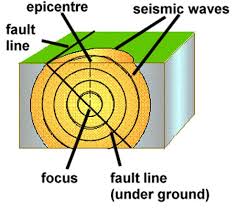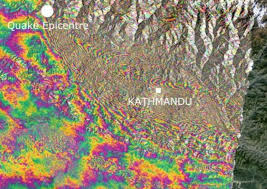Overview
Earthquakes are caused when energy is suddenly released in the earth’s crust, so that it shakes and trembles. Most are mild, but some are violent, resulting in massive devastation, injury, and loss of life, such as the recent earthquakes in Nepal in April and May, 2015
Why Earthquakes?
The tectonic plates that make up the Earth’s crust move and slide past one another, so that the rocks on the boundaries constantly store elastic energy. When the energy is released, movement fractures the rock, resulting in an earthquake. Some types occur because the tectonic plates collide with one another, while others happen because the plates either slide past each other or slide apart and form a rift. The plates do not slide smoothly, but stick and jerk as they move.
Seismic Waves
Waves are created by the energy from an earthquake as it is transmitted past its focus. Seismic waves called body waves flow outward from a point below the surface of the earth. Primary waves are caused by the compression of rock and are the first to reach an observer, while secondary waves are transmitted more slowly, and only move through solids. Surface waves travel from the epicenter of the earthquake. Some are long waves that travel up and down, while others travel from side to side.
The Richter Scale
The Richter, or moment magnitude scale, is used to measure the strength of seismic waves as measured by a seismograph. It is a logarithmic scale for measuring the amplitude of those waves. The taller the wave, the more energy is released. Each magnitude is 10 times greater than the one before it. Millions of micro-earthquakes occur every year, at the lowest reaches of the scale. They cause little to no damage, and most people cannot even feel them. In contrast, the Nepal earthquake April 25 measured 7.8 on the Richter scale, while one of its largest aftershocks measured 7.3. The most recent pictures from space showed movement of large areas on the surface of the earth, at distances of 7-10 meters.
Earthquake Zones
Nearly 90% of the world’s earthquakes occur around the Ring of Fire, an area that stretches along the western United States, Canada, Mexico, Central, and South America, through western Alaska and the Aleutian Islands, to eastern Russia, Japan, Indonesia, the Philippines, all bordering the Pacific Ocean. Another active area extends from Java to Sumatra through the Himalayas, the Mediterranean, and out into the Atlantic. Collision between the India and the Eurasia tectonic plates caused the formation of the Himalayan mountain ranges and numerous earthquakes in the region.
Interested in science tutoring services? Learn more about how we are assisting thousands of students each academic year.
SchoolTutoring Academy is the premier educational services company for K-12 and college students. We offer tutoring programs for students in K-12, AP classes, and college. To learn more about how we help parents and students in Washington, DC: visit Tutoring in Washington, DC




